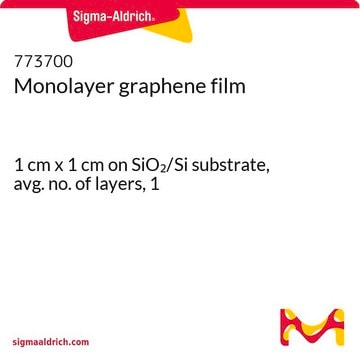GRFETS20
Graphene FET chip
S20
Synonym(s):
2-probe FET device, 2-probe Graphene FET sensor, Chemical gated Graphene FET, GFET S20, Graphene field effect transistor chip S20
About This Item
Recommended Products
description
Absolute Maximum Ratings
Maximum gate-source voltage: ± 50 V
Maximum temperature rating: 150 °C
Maximum drain-source current density: 107 A/cm2
Chip dimensions: 10 mm x 10 mm
Chip thickness: 675 μm
Dirac point: < 50 V
Yield >75%
Encapsulation: 50 nm Al2O3 + 100 nm Si3N4
Gate oxide materials: 90 nm SiO2
Graphene field-effect mobility: >1000 cm2/V·s
Monolayer CVD grown Graphene based 2-probe field effect transistors (FET).
Number of devices per chip: 12
Resistivity of substrate: 1-10 Ω·cm
Metallization: Chromium/Gold-Palladium 2/50 nm
Looking for similar products? Visit Product Comparison Guide
General description
The graphene FET-S20 chip is designed for measurements in liquid medium. This chip provides 12 graphene devices, with encapsulation on the metal pads to avoid degradation and reduce leakage currents, and the probe pads located near the periphery of the chip. It also includes a non-encapsulated electrode at the center of the chip, which allows liquid gating without the need of an external gate electrode.
Application
- Bioelectronics
- FET based sensor research for active materials deposited on graphene
- Clinical applications
- Biosensors
Features and Benefits
- State-of-the-art GFETs utilizing consistently high-quality CVD monolayer graphene
- Metallic contacts and metal/graphene interface are encapsulated to avoid degradation and reduce leakage current in liquid environment
- Perfect platform device for new sensor research and development
- 12 individual GFETs per chip
- A central gate electrode
Storage Class Code
11 - Combustible Solids
WGK
nwg
Flash Point(F)
Not applicable
Flash Point(C)
Not applicable
Certificates of Analysis (COA)
Search for Certificates of Analysis (COA) by entering the products Lot/Batch Number. Lot and Batch Numbers can be found on a product’s label following the words ‘Lot’ or ‘Batch’.
Already Own This Product?
Find documentation for the products that you have recently purchased in the Document Library.
Articles
Graphene nanoribbons (GNRs) are quasi-one-dimensional narrow strips of graphene comprised of sp2-hybridized carbon atoms arranged into hexagonal honeycomb lattice configurations.
Our team of scientists has experience in all areas of research including Life Science, Material Science, Chemical Synthesis, Chromatography, Analytical and many others.
Contact Technical Service






